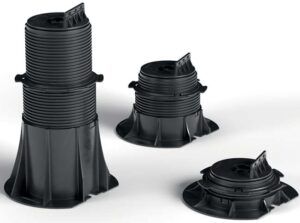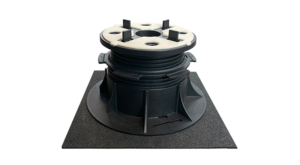Building a floating deck on a flat roof is a practical way to enhance outdoor living space while optimizing the use of your home’s structure. However, flat roofs often feature a slight slope to promote drainage, presenting a unique challenge when constructing a level deck. Constructing a rooftop deck by means of a floating roof deck system using adjustable height deck pedestals and porcelain pavers offers an elegant solution, allowing you to build a stable, level, and visually appealing rooftop deck while preserving the roof’s integrity. This blog post outlines the steps and considerations for this type of deck construction.
Understanding the Challenges of Rooftop Deck Construction
Flat roofs, contrary to their name, usually have a slight slope (1-2%) to ensure proper drainage. This sloped surface can make traditional deck-building methods difficult because achieving a level surface becomes challenging. Additionally, building on a roof requires careful consideration of weight distribution, waterproofing, and the materials used to prevent damage to the roof membrane.
Adjustable height deck pedestals address these challenges by providing a stable base for porcelain, concrete or wood pavers that compensates for the roof’s slope without directly fastening to the roof, preserving its integrity.
Why Use Adjustable Pedestals and Porcelain Pavers?
Adjustable pedestals enable you to make precise height adjustments to compensate for sloped surfaces, simply by screwing the pedestals up or down, ensuring your deck is perfectly level.
When paired with porcelain pavers, they create a very attractive ‘floating’ roof deck that doesn’t damage or penetrate the roof membrane, avoiding water leaks, reducing the weight on the roof compared with a more traditional support system of wood or steel joists, and provides a clean, modern aesthetic.
Step-by-Step Guide to Building a Level Floating Deck on a Roof
-
Assess Your Roof’s Suitability
Before starting, you should always consult a structural engineer or roofing professional to ensure your roof can support the additional load of the deck, furniture, and people. Roofs typically have weight-bearing limits, so understanding this is crucial for safety.
Verify the condition of the roof membrane, as it acts as a waterproof barrier. If it’s worn or damaged, consider repairs or the installation of a protective underlayment before proceeding.
-
Select Materials
Choosing the right materials is key to a durable and functional rooftop deck:
- Pavers: Porcelain, concrete, or wood pavers are durable, attractive, and easy to install on pedestals. Porcelain and Ipe wood are much lighter than concrete and are generally preferred to reduce the load on the roof, although wind uplift is a factor to consider in windy locations.
- Deck Pedestals: Adjustable pedestals should have features like slope correction, rubber surfaced heads to reduce noise transmission, inbuilt spacers to ensure precise gaps between pavers, the ability to make precise height adjustments, and strong weight-bearing capacities.
- Protective Pads: Rubber pads can be placed under the pedestals to provide further protection of the roof membrane and greater sound deadening if desired.
-
Plan the Deck Layout
Sketch out the design of your deck, keeping in mind the roof’s size, shape, and any obstacles like vents, skylights, or drainage systems. Ensure proper spacing for drainage pathways and access to maintenance points.
Consider the slope of the roof during planning; the deck’s layout should work with the roof’s drainage system, not obstruct it.
Check if the pedestal supplier has online pedestal and paver estimating software that can help considerably in estimating how many pavers and pedestals you will need.
-
Prepare the Roof Surface
Clean the roof thoroughly, removing debris and ensuring a smooth surface. Place protective pads (if being used) under each pedestal to minimize the possibility of any damage to the roof membrane and ensure an anti-slip base for the supports.
-
Lay Out the Adjustable Deck Pedestals

- Position the Pedestals
Arrange the pedestals in a grid pattern based on the size of the pavers. Typical spacing is 24 inches in both directions, depending on the paver size and thickness. - Adjust for Slope Compensation
It’s best to use pedestals that have built-in slope correction capabilities. These allow you to counteract the roof’s incline (typically 2%) and create a level surface. Adjust pedestal heights using a spirit level to ensure accuracy.
-
Lay Out the Pavers
Once the pedestals are positioned and adjusted:
- Place the Pavers: Place the pavers onto the pedestal heads, ensuring they are butted tightly against the upright tabs on the pedestal heads. The tabs not only ensure precise gapping but allow water to flow freely off the deck.
- Check for Levelness: Continuously check that the pavers are level using a spirit level or laser level as you progress across the deck.
-
Check Drains are Clear
Maintaining the roof’s drainage functionality is critical. Adjustable pedestals ensure the deck surface is level while preserving the roof’s slope beneath. Ensure that water can flow unobstructed to drains or scuppers by leaving clear pathways beneath the deck and making sure pedestals do not cover any drains.
Ensuring Safety and Security
- Edge Restraint: On elevated decks it is very important that the decking is constrained by a low parapet or other means to prevent pavers from shifting over time. The gap between the parapet wall and the perimeter pavers should be no more than ¼”.
- Railings and Safety Features: Install railings or barriers for safety, especially if the deck is elevated. Use systems compatible with floating decks to avoid roof penetration.
 Advantages of Using Adjustable Pedestals and Pavers
Advantages of Using Adjustable Pedestals and Pavers
- Level Surface on a Sloped Roof: Pedestals with self-leveling slope-correcting capability make it easy to create a perfectly level deck, even on inclined surfaces.
- Preserves Roof Integrity: The floating design avoids penetration of the roof membrane, preventing leaks and preserving waterproofing.
- Durable and Stable: Pavers provide a robust, low-maintenance surface resistant to weathering and wear.
- Customizable Design: Adjustable pedestals allow for various paver materials, colors, sizes, and designs to be used, offering exceptional flexibility in deck layout.
- Easy Maintenance: The modular system allows for easy removal of pavers and pedestals for roof inspections or repairs.
Maintenance Tips for Your Floating Rooftop Deck
To keep your deck in top condition:
- Inspect Periodically: Check the stability of deck supports and the condition of pavers regularly.
- Clean the Deck Surface: Remove debris and clean pavers to prevent staining or moss growth.
- Monitor Drainage: Ensure drainage pathways remain unobstructed to avoid water pooling.
- Check the Roof Membrane: Periodically inspect the membrane for any signs of damage beneath the deck.
Summary
Building a floating roof deck on a flat roof using adjustable deck supports and pavers is an efficient and stylish solution for expanding your outdoor living space. This method simplifies construction, preserves roof integrity, and delivers a durable, low-maintenance deck. By following the steps outlined in this guide, you can create a rooftop retreat that combines functionality with aesthetic appeal, transforming your roof into a beautiful and versatile space.


 Advantages of Using Adjustable Pedestals and Pavers
Advantages of Using Adjustable Pedestals and Pavers